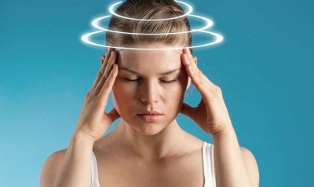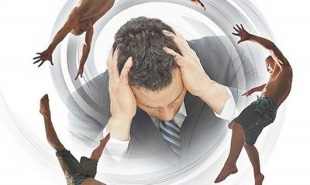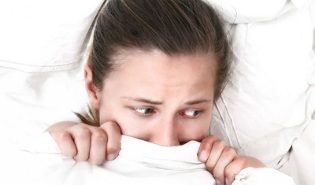
Spinal pathology often causes completely unexpected symptoms.
At first glance, they have nothing to do with the disease. But - a person has cervical osteochondrosis, and dizziness, fear and depression can also be a part of his life easily.
For successful treatment, it is important to correctly identify the cause of the problem.
Dizziness in osteochondrosis: the cause of occurrence
Cervical osteochondrosis is very dangerous because it interferes with the blood supply to the brain. Disc and spinal deformities can compress the vertebral arteries, providing up to a quarter of the amount of blood the brain needs.
Dizziness is a direct result of oxygen starvation in the brain. At the milder stage of the disease, it usually occurs intermittently and for short periods of time. The head may feel dizzy after sleep or when there is a sudden change in body position. If the disease persists, the condition can last for hours. Often it is also accompanied by nausea, vomiting, visual disturbances.
It is very important to identify the cause of the problem correctly. The head can be dizzy not only from osteochondrosis. The same symptoms can be caused by heart and blood vessel disorders, anemia and other diseases. In this case, the treatment approach must be completely different. Often, misdiagnosis causes people to be treated for years for high blood pressure or other similar diseases than to deal with the spine.
Blood pressure and cervical osteochondrosis
In this case, cervical osteochondrosis can also cause manifestations of vegetative-vascular dystonia. The cause also lies in pinching the vertebral arteries, as well as muscle spasms. Intracranial pressure responds primarily to painful osteochondrosis.

This phenomenon can manifest itself as headache, heaviness, tinnitus, vision impairment. The use of conventional medicine for the treatment of hypertension does not give results (or they are short-lived). Again, a correct diagnosis is the key to treatment success.
Increased stress can also cause pain, so the manifestations of VSD in osteochondrosis can be very strong.
If, in addition to the neck, the thoracic area is also affected, disturbances in the heart, arrhythmias, and chest tightness can be seen. Again, heart medication does not work.
Osteochondrosis is very dangerous because it gives symptoms similar to other serious disease manifestations. A lot can be attributed to it, and you can miss a moment when you need immediate help for your heart and blood vessels.
What to do if you feel dizzy with cervical osteochondrosis
If a diagnosis has not been made, it is possible to suspect dizziness due to osteochondrosis if it occurs while changing posture. Also, the neck is usually cracked.
Vertigo can be eliminated by maintaining normal blood circulation in the neck. You can try self-massage as a quick-acting remedy. To prevent recurrent attacks, you should undergo treatment. What to do in certain situations, the doctor will advise.
Different medications and therapies may be needed at different stages of the disease:
- Muscle relaxation course to relax muscle spasms.
- Vitamin B - it also has a good effect on blood circulation.
- A few massage sessions with a specialist, then a regular neck massage.
- Physiotherapy is a must - movement will help release the pinched ducts and stimulate blood flow.
Prolonged exposure to fresh air works well. You should quit smoking and limit alcohol intake, as these bad habits have a negative impact on blood circulation. And the main thing is to diagnose cervical osteochondrosis in time, and dizziness, fear and depression will not have time to develop.
Reasonable and unfounded fears in osteochondrosis
Osteochondrosis presents manifestations not only physically, but also psychologically. Often, the disease is accompanied by panic attacks and obsessive fears.

Their appearance has objective and subjective reasons. Unreasonable panic may be caused by a cerebrovascular accident.
But more frequent fears are the result of painful manifestations of osteochondrosis:
- Patients are always waiting for a painful attack and are afraid of it.
- There are concerns about the possibility of becoming disabled.
- Duration of treatment is daunting with the possibility of no results.
- Some symptoms cause the expectation of other diseases (heart attack, stroke, abdominal pain).
Such psychological reactions can be avoided only with appropriate attitude. The patient should always remind himself that osteochondrosis is not a sentence. Do not neglect the pain reliever so that there is no fear of pain. Relatives and acquaintances of the patient should always show confidence in his speedy recovery and maintain a constructive attitude.
Depression as a possible consequence of osteochondrosis
If "psychotherapy" is not performed, there is a risk of depression.
This condition can have a variety of unpleasant consequences:
- Loss of performance, chronic fatigue syndrome.
- Insomnia.
- Mental impairment.
- Serious violation of self-esteem.
- Menstrual irregularities in women.
- Digestive disorders.
- Numbness in certain parts of the body.
Running depression can even lead to suicide attempts, so ignoring the manifestations is dangerous.
Depression occurs as a reaction to prolonged pain and discomfort. Its appearance is also driven by social problems that inevitably accompany patients with osteochondrosis.
- Feel the lost opportunity to live a satisfying life.
- Prolonged "school break" from the labor process.
- Awareness that illness causes the discomfort of a loved one.
- Feelings of helplessness, futile effort - the disease will not go away even if action is taken.
It is important to take into account that some pain relievers also have a depressing effect on the central nervous system and can lead to depressive conditions. Therefore, one should not abuse strong analgesics, using them only to aggravate. If there is no severe pain, it is better to use ointments, massages and physiotherapy procedures. Relatives of patients should take into account that depression often prevents patients from being aware of their problems, so they will definitely "push" him or her towards treatment.
Treatment of psychological problems in osteochondrosis
If there is severe depression with many dangerous manifestations, it is often necessary to use strong antidepressants. But you should know that all of these drugs have addictive effects, and you should not use them for long periods of time. Once the worst manifestations are removed, such medications should be discontinued.
To get rid of fear and depression, first of all, it is necessary to treat osteochondrosis itself. A set of standard measures suitable for this: elimination of muscle spasms, chondroprotectors to strengthen cartilage tissue, exercise, physiotherapy. But at the same time it is necessary to improve the mental state of the patient.
- Walking and moderate physical activity are required. Slight physical activity stimulates pleasure.
- To normalize sleep, you need an orthopedic pillow or just a low hard pillow. The bedroom must always be well ventilated.
- Others should motivate the patient to recover.
- It is necessary, as far as possible, to involve patients in public life, family affairs, and official duties. In most cases, you can find activities that will not hurt your spine. But the person will feel useful and needed.
- In severe cases, psychological help as well as psychiatry may be needed. No need to fear - going to psychiatry does not mean losing your mind.
The main thing is to "order" cervical osteochondrosis, and dizziness, fear and depression will stop threatening. Against the background of a decrease in painful manifestations, psychological recovery will be better.
But the best thing to do is to avoid these symptoms. Need to start treatment of cervical osteochondrosis in a timely manner, and dizziness, fear and depression will not appear.





































